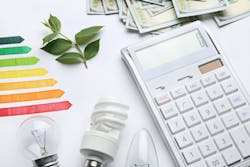With governments, employees and consumers breathing down their necks about sustainability and faced with the reality of resource scarcity, manufacturers have no choice but to embrace robust ESG strategies even if no one knows the total cost and whether it will actually improve the environment or not.
The 2023 Rockwell Automation Fair featured the annual event’s first ESG Summit, with a keynote delivered to around 250 manufacturers in a ballroom at the Omni Plaza Hotel in Boston.
“We have to help the world change, specifically the manufacturing world. We [represent] 40% of the [world’s carbon] emissions. We have to help this change so that our children have a future in this world,” said Tom O’Reilly, Rockwell’s vice president for sustainability.
In fairness, the vast majority of motivations cited at the summit for manufacturers to develop their ESG policies were practical and not sentimental. For instance, the rising tide of ESG regulations that manufacturers have to face, beginning with the EU’s Corporate Sustainability Reporting Directive (CSRD) that will force any publicly-listed company in Europe to report emissions and reduction targets.
“Any multinational that sells more than $150 million in Europe has to do this too. So, basically, any large multinational in the U.S. or others will also have to do this,” O’Reilly said.
Slow Progress on Energy Policy
Alex West, senior principal analyst of industrial sustainability at research firm Omdia, presented encouraging data like growth in renewable energy consumption from 14% in 2019 to 20% in 2021 and reporting that two-thirds of manufacturing companies in a recent study stated they will increase investment in sustainability over the next 12 months.
On the other hand, consumption of fossil fuels has plateaued over the past five years, and less than a quarter of the companies who said they would invest more than 10% of their budget into sustainability initiatives actually did so.
West argued that manufacturers need to accelerate their efforts, if not out of concern for the environment, then to address the bottom line.
“Around 40% of companies see [energy] as a major cost load, up to 15% of their overall operational costs,” said West. Even so, profits and sustainability seem at odds with one another, in general.
“When the market is good, people focus on efficiency, people focus on these initiatives and energy intensity goes down. Then, when the market struggles, you start seeing the inverse, and people start cutting back on initiatives, people backtrack on commitments and it becomes a race to focus on revenues and profits,” said West.
“And obviously, in the state we’re in at the moment … a number of countries either facing recession, in recession or facing market slowdown, the big question is, how are we going to push on over the next couple of years?” added West.
Carbon emission reduction targets are also behind schedule, in part because adopting renewable energy presents challenges like intermittency, grid resiliency and battery procurement.
“The race to net zero will not rely on renewable energy alone. Energy efficiency is going to be a key part in this transition,” West said. And there are simple steps manufacturers can take to get started, like optimizing the use of industrial motors.
“Something as simple as applying a motor drive, some electronics to control and optimize the speed of a motor, can lead to significant energy savings,” West said.
Manufacturers can also begin tracking energy use at a more granular level. Rather than measuring consumption at the site level, tracking energy use by individual processes at plants may provide energy efficiency insights.
Production of this data also provides the visibility manufacturers will need to meet reporting requirements. Rather than sustainability projects operating in silos across an organization, collecting the data together makes it easier to determine whether manufacturers meet sustainability goals and whether initiatives even make a difference in the first place, says West.
The Water Pressure is Rising
Matt Howard, vice president for water stewardship at The Water Council, said that data trend projections suggest a 40% gap in water availability by 2030. So from a business perspective, whether manufacturers use water in processes, as inputs to production or for cooling, they need to become more aware of how they’re using and impacting water resources and assessing their risk conditions.
“Water is not fungible. If I save 1,000 gallons of water at my manufacturing facility in Chicago, that’s great, but it has absolutely no bearing on the same type of facility in Phoenix. If you’re an organization or company and you’ve got multiple sites located all over the place, all over the U.S. or globally, each one essentially has a unique risk profile as it relates to water use,” Howard said.
Regulation will rear its ugly head here, as well. Companies will increasingly have to report on what actions they take to assess and address their water challenges, and manufacturers aren’t on the ball.
“Last year, approximately 19,000 companies reported on CDP [Carbon Disclosure Project] climate reporting…but only 4,000 companies reported on the CDP water security questionnaire,” said Howard.
“And in fact, if you look at those companies that did the water security questionnaire for CDP, of those that identified water as a risk to their operations, just about half are actually setting targets and tracking and measuring progress as targets,” Howard added.
Are OEE and Sustainability the Same KPIs?
Andy Kohok, managing director at Accenture Strategy, believes that the same networks of IoT devices spread across plant floors that manufacturers use to measure OEE could also measure sustainability.
“Every plant has multiple tools, and they can give you an answer with 99.7% accuracy on what their OEE is. Why can’t we do the same with sustainability? … Where are you consuming energy on the production floor? Where are you making waste or wastewater on the production floor? The same assembly line that is [producing goods] is also impacting carbon emissions, water, energy,” Kohok said.
“If you improve your production line, you should be able to predict the impact on sustainability. … If you’re a line supervisor, you should know which assets you’re using and [whether you are] using them efficiently. Are you going to have a positive or negative impact on sustainability goals? Only then you can make the right decision at the intersection of productivity and sustainability,” Kohok adds.
Funneling all the information gathered by IoT devices into a single point of collection and then feeding that data through artificial intelligence and machine learning algorithms can provide the insights manufacturers need to increase energy efficiency, reduce carbon emissions and prevent water wastage, providing the information manufactures need to set realistic and attainable targets.
But How Much Will it Cost?
The justifications presented at the summit for manufacturers to embrace robust sustainability policies, the benefits they might enjoy by doing so and the technology solutions at their disposal are common refrains in ESG discussions. How to assess the costs of requisite investments and org changes and predict the results on short- and long-term profits remains elusive, even if that’s the information manufacturers need the most.
“What’s the business case for investing in technology when every six months it changes completely? … If you talk to a CFO [they may] say ‘Let’s wait for a while. And let’s wait for the more efficient version of the technology to come in.’ And of course, the answer from the technology companies is ‘Let’s go on the cloud, the cloud allows the agility to keep upgrading and changing,’” says economic advisor and analyst Pranjal Sharma.
“Well, it’s not just about software. It’s also about the hardware. So I think it’s a very perplexing question right now, and I don’t think anybody has a clear answer,” Sharma adds.
Another important question for Sharma—how to assess the environmental effects of addressing environmental effects. The energy used to manufacture and charge EV batteries comes from burning coal, for example. Mining the lithium for EV batteries is a water-intensive process.
“When you push all these new IoT sensors to track energy and to reduce wastage, the energy required to manage the data, is that higher than the energy that you’re saving?” asked Sharma, referring to the energy costs of maintaining all the new data centers.
“I think we need to step back, and I’m giving a slightly broader view, to see that every initiative that we take, do we have an assessment of the net positive impact of that? Or are we just hurtling down a path because we see immediate short term impact? But perhaps the long term impact is difficult to assess?” Sharma adds.
For West, manufacturers must calculate the cost of inaction.
“We hear about legislation, there’s going to be issues around access to capital, talent, pressure from the supply chain partners, governmental influences around both subsidies and taxation, things like carbon taxes, that’s going to change what the actual profit point is and give those companies and sustainability leaders a real green differentiation as well,” West says.







